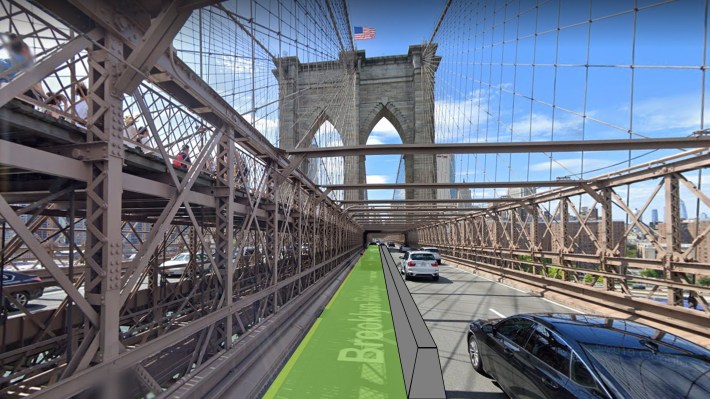Mayor de Blasio will announce one of the most significant repurposing of space from drivers to cyclists of his entire seven-year tenure — adding a lane for cyclists on both the Brooklyn and Queensboro bridges, an acknowledgement that the boom in cycling has created unsafe conditions that are inhibiting further growth in this sustainable transportation method.
The New York Times broke the story today, but Streetsblog has been able to fill out more details:
- The cycling lane on the Brooklyn Bridge will be an eight-foot-wide, two-way lane on the inner lane of the Manhattan-bound side. The existing shared pedestrian and cycling path above the roadway will be set aside for pedestrians only.
- The lane will be completed by the end of this year.
- On the Queensboro, the north outer roadway will be set aside only for cyclists, with the south outer roadway being converted into pedestrian space, as it was for many years until Mayor Giuliani took it back for cars.
- That work will begin this year but won't be done until 2022.

The announcement will come in the mayor's State of the City address tonight, when Hizzoner is expected to explain his motivations behind what advocates hope is merely an opening salvo in his "Bridges for the People" proposal, which follows Transportation Alternatives' "Bridges 4 People" campaign: "Now, it’s time to bring them [the bridges] into the 21st century and embrace the future with a radical new plan."
As such, TransAlt Executive Director Danny Harris was excited.
“Converting car lanes into bike lanes on two of our most important bridges is a giant leap forward for New York City," he said. "We look forward to working with the de Blasio administration on this vital new project and other efforts to improve infrastructure for cyclists and pedestrians on bridges and streets across the five boroughs.”
Streetsblog reached out to DOT for more details, but the news represents a massive victory for cyclists and their advocates, whose work (as seen in this 2016 clip) has been painstakingly documented by Streetsblog, which has been the leading outlet calling for safe conditions for bikers and walkers on both jam-packed bridges.
"It's one of the most important victories for the movement toward a city that actually doesn't just talk about Vision Zero, but does the work of accomplishing Vision Zero," said Council Member Jimmy Van Bramer, who, along with his Manhattan counterpart Ben Kallos, were so frustrated by the city's delays that they offered to fund the Queensboro Bridge project themselves. "And obviously, the bridges need to be safe for everyone. On the Queensboro Bridge, this was a clear and present danger, even more so given the pandemic with so many more people biking to work and, as I do, to my dentist's office."
They don't always make it easy on us, but @StreetsblogNYC deserves credit for extensive reporting on this issue.
— Mitch Schwartz (@mhschwartz10) January 28, 2021
This is a cool day and they played an important role. Good on em https://t.co/ADqyWas7nV
Van Bramer and Kallos both credited the activists who have been pushing for the improvements for years.
"There was a coalition, including advocates like Charles Komanoff, Transportation Alternatives and Streetsblog and so many others that worked for years that culminated in a walk across Queensboro Bridge as an act of protest that led to a legal walk-through with elected officials," Kallos said. "This is a moment to say we did it. Bike riders from Manhattan and Queens, rejoice. We won. It is good that the mayor heard the call and acted."
Bike New York spokesman Jon Orcutt was more succinct.
"Hallelujah! The bike boom response we’ve been waiting for!" said Orcutt, a former DOT official under Mayor Bloomberg. "Thanks to Mayor de Blasio and DOT Commissioner [Margaret] Forgione!"
If anyone is crediting Streetsblog, it might be because of the outlet's relentless coverage of the dangerous conditions on both bridges, dating back years. The site's coverage, however, intensified more recently as cycling has increased over all East River bridges, most notably on the dangerous Queensboro, and culminated with Streetsblog lining up financing from Kallos and Van Bramer last year for the pedestrianization of the south outer roadway, a project Streetsblog took on after the DOT claimed it could not do the work because it was too expensive.
Streetsblog also focused attention on conditions on the Brooklyn Bridge foot- and bike path, which, during normal times, is jam packed with tourists and two-wheeling commuters. Advocates have been pressing the city to repair the dangerous conditions on the bridge for at least a decade, most recently in a letter from three Council Members to the DOT in 2019, and architect John Massengale's proposal that the bridge's roadway to be entirely car-free.
Streetsblog itself offered five immediate changes that the DOT could make without any serious engineering issues. Our coverage culminated in an apology from then-DOT Commissioner Polly Trottenberg about her agency's failure to create more space on the span.
Drivers will likely complain about losing a lane of Manhattan-bound traffic on the Brooklyn Bridge, but the onset of congestion pricing, which in the best case scenario could start in a year, would decrease the amount of traffic on the span — and allow city officials to repurpose road space, as they have long promised. And any increase in traffic would be short-term, based on the corollary to the notion of induced demand, which posits that the better a roadway is for drivers, the more drivers will flock to it, making it a traffic-clogged mess.
State Senator Mike Gianaris of Queens also hailed activists for their years of work.
"The new bike and pedestrian lanes will make crossing the East River safer for everyone and change how we move around our city for the better," he said. "I stand ready to help get this done at the earliest opportunity.”
All articles in our Streetsblog Gets Action series are archived here. Today's story is obviously a huge entry.






